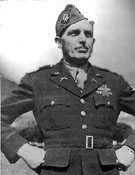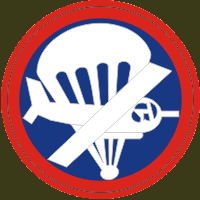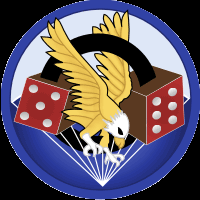|
|
.
506th PIR . Parachute
Infantry Regiment |
|
 <-Lieutenant Colonel Robert F. Sink
<-Lieutenant Colonel Robert F. Sink
This unit
was creates on July 20, 1942 under the orders of Lieutenant
Colonel Robert F. Sink.
Sink is a former member of 501st PIR. As the others order regiment “Bounding Bob” wanted to inculcate its own model of control and formation.
This formation, very hard, was to thereafter serve the men on the battle fields, especially when they should go of long distance in very short period. They were involved 12 hours per days, the whole to form their endurance.
This formation took place with camp Toccoa, in Georgia close to the mountains Currahee. “Currahee” means we only fight as an Indian. The soldiers immediately adopted this currency for the regiment. In addition to the drive, the men were to climb and descend daily the mountain.
They made also long walk of night to the compass. And finally, there was the course of obstacle “that only a sadistic monster liking torture could inventer”. The program of drive was hardest of all the army. With Toccoa camp, the men had also the first stage when with their qualification as a parachutist in particular the jump of a tower of 10 meters.
At the end of November 42, it 506th is sent to Fort Benning to follow its training of parachutist. The 1er battalion went there by train, the 2nd battalion left Toccoa to foot, then after having traversed 185km with foot, they are gotten into a train to finish the voyage to foot. 3rd battalion left by train until Atlanta then traversed the 219km remainder with foot beating of this fact the preceding record of the world held by the Japanese army. The men had to transport all their equipment.
With Fort Benning begin the second phase of the drive, in particular of the jumps of turns of 76 meters with the feeling to have a true parachute which opens. They learned how to fold their own parachute and to prepare their equipment to be released in an airborne operation. At the end of the formation, they were qualified as parachutist with obtaining their wings.
Once this instruction finished, the regiment was sent with Mackall camp to follow a tactical formation, including jumps of nights the whole with the complete equipment.
506th was attached to 101st June first, 1943. A few days later, the regiment took part in army maneuvres in Tennessee. The regiment was released behind the lines "ennemies" and were to establish stoppings lorry driver and to destroy bridges and the communication systems. Then, the regiment was sent to strong Bragg until the end August 43. With strong Bragg, it y have in particular a procession to organize in front of Generals and in particular the Foreign Minister, Sir Anthony Eden.
At the end of August, it was sent to New York with Shanks camp and ready to embark direction The United Kingdom.
506th embarked on board S.S.Samaria, crossed the Atlantic to arrive at Liverpool on September 15, 1943.
In England, it 506th was posted in Wiltshire with units stationed with Aldbourne, Ramsbury, Froxfield and Chilton-Foliat.
In England, the unit took part in exercises such as the operation “Wadham and Rankin” for the next invasion on the continent.
June 5, 44, the men are close to C-47 who will transport them in their first mission of combat.
Photo
"E"
Photo "F" Co
![]() D-DAY – June
44 – Normandy – France – Operation Neptune
D-DAY – June
44 – Normandy – France – Operation Neptune
Operation 506th Map
506th took off on June 6, 44 with 1h00. A few front hours are parachuting, the German Flak combination and large clouds dispersed the formation of C-47. Only 9 planes out of 81 programmed to release their sticks on the DZ C (drop zone) found their reference marks. Certain sticks have lands with more than 30 km of their sector. Only it 3rd battalion unloaded near their DZ.
Unfortunately, this zone was already identified like probable zone of jump by the Germans. They had thus prepared a trap to receive the parachutists.
In less than 10 minutes, the commander of the 3rd battalion, it Lieutenant Colonel Wolverton was killed like its assistant, it Major George Grant and most of the battalion.
The only ones which escaped with the massacre are those which landed far from their DZ. These two units ordered by Captain Charles Shettle will manage to achieve the objectives of the battalion, i.e. captures it of two bridges above the river Douve.
The men of the other battalions fought within small groups.
Men of company E destroyed in particular the guns aiming at the beaches of Utah Beach battery of Brécourt.
In the morning of the unloading on the beaches, 506th fills its objectives.
506th also took part in the catch of the city of Carentan.
June 29, 101st was replaced by VIII Body and sent to Cherbourg to relieve 4th Infantry Division.
506th remained in France like forces of reserve until July 10. On this date, it is returned in England for formation and rest.
In August 44, Eisenhower the first allied airborne army made up of the American, English and Polish forces establishes.
This new army was used for the first time in Holland, in September 44.
 Holland
–
September 1944 –
Operation Market-Garden
Holland
–
September 1944 –
Operation Market-Garden
It was a daring plan imagined by British Field Marshall Montgomery would be the first airborne attack of full day since the attack of the Germans on Crete.
The attack, programmed for September 17, 44 aimed at the catch of the roads, the bridges, the bridges ferrovières and the principal towns of communication ofEindhoven, Nimègue and Arnhem and thus to cut out Holland in two and to release a corridor to support the columns of armoured British to the German border.
The objective of 101st is to control 16km road (to call road of the hell) extending from North from Eindhoven with Veghel.
After less than three months spent to England, it 506th was to carry out its second jump of combat.
The zone of jump is the DZ B with for objective the catch of the bridges span the channel Wilhemina with Its, then to move towards the south and to take the city of Eindhoven with its roads and its 4 roads above Dommel. On September 17, 44, with 13H15, the whole regiment landed in a field and advanced towards Its without too much difficulty.
While arriving at its, it 1st battalion, carried out by Major James L. LaPrade, both bridge.
At day J+1, bridges of Eindhoven are controlled and to 18h30, the armoured English units could enter the city.
D-day, until November 1944, men of 506th familiarized themselves with names such as St Oedenrode, Uden, Veghel, Koevering, Opheusden and Randwijk combatant of city downtown and pushing back against attacks on against attacks enemy.
At the end of November, the unit is sent in rest in an old French artillery garrison just apart from the village of Mourmelon in France.
![]() Belgium –
December 1944 – Battle
of the Bulge
Belgium –
December 1944 – Battle
of the Bulge
To the paddle of December 16, 1944, the Germans launch a great offensive crossing the forest of the Ardennes meeting the American defenses ensured by VII Corps.
Objective, the catch ofAntwerp, only close port which feeds the Allied troops.
This moment there, 101st as well as 82nd is in rest in France and to keep like forces of reserves.
101st was quickly dispatched towards the city of Bastogne, strategic city for the Germans bus with the crossroads of several important roads for their offensive.
101st did lot of mileage in the night of December 18 on board trucks.
Forces of 101st made obstacle with the offensive of Hasso von Manteuffel’s 5th Panzer.
Following days, Bastogne was encircled.
506th with defended the sector on the side East.
Like all the other regiments of 101st, men of 506th requested that C-47 supply them in necessary essence.
To finish, on December 26 tanks belonging to 4th division of Patton’s III US Army broke surrounding.
January 15, 1945, it 506th takes the city of Noville.
It will remain on this objective until January 20 when it will be sent in Alsace, in France where the German offensive “ Nordwind” had begun.
This offensive under the command of Heinrich Himmler threatened the sector of 7th army.
Remaining on the line of face, 506th PIR took part in no operation the main thing, it carried out only patrols to keep the contact with the enemies.
February 23, 1945, 506th is returned to Mourmelon for rest. There it general Eisenhower allotted to the whole of 101st Distinguished Links Quotation for its bravery with Bastogne.
 End – 1945
End – 1945
The war approached the end, 506th was sent in the pocket of Rhur on April 2. 506th a line was due facing The Rhine in the south of Düsseldorf.
May 4, the last mission of 506th is the catch of Berchtesgaden, the Hitler’s “Eagel’s nest”.
May 8, 1945, it Colonel Sink accepted the rendering of LXXXII German Corps ordered by Lieutenant General Theodor Tolsdorf.
506th the area occupied of Zell Am See until the end July dates to which it was returned to Joigny in France.
November 30, it 506th PIR was dissolves and its some remaining members were replaced in other units.
United States :
2 Presidential Distinguished Unit Citations for operations in Normandie and Bastogne
France :
War Cross with palms for the Normandy operation
Belgium :
2 War Cross and Lanyard for the Bastogne operations
Holland :
Lanyard Oranje from the Netherlands for the operation Market Garden

